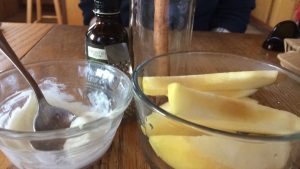Week 7 was spent applying information learned from “The multisensory perception of flavor” (https://doi.org/10.3389/fpsyg.2013.00321) and “As bitter as a trombone: Synesthetic correspondences in non synesthetes between tastes/flavors and musical notes” (doi:10.3758/APP.72.7.1994) a tasting lab in Week 8.
When looking at figure 3 in the synesthetic correspondences in non synesthetes article, I saw that there was a higher approval rate amongst the tasters for the piano sound throughout the five groups in the pleasantness rating graph relative to the approval rating of the brass in the intensity and the complexity graphs, and a relatively neutral response for the strings and woodwinds.
“Brass was often matched to unpleasant stimuli, whereas the piano was preferred for pleasant tastes/flavors” (Cristinel & Spence)
The table 1 chart shows that vanilla and sucrose had an extraordinarily high concentration relative to the incredibly low concentration of the citric acid and caffeine. Figure 2 shows that out of a maximum count of 68 (34 participants doing two tests) at least 10 more people matched piano to sucrose and brass instruments to caffeine than the correlation with the pairing of strings and woodwind instruments to coffee. The appreciation of sucrose and caffeine may be related to what type of memories are paired with those flavor associations.
“The main point is that, whereas the representation of smells in the olfactory bulb is driven by stimulus properties, the representation in the olfactory cortex is memory based.” (Shepherd: 103)
“In the west, we describe the aromas of strawberry, caramel, and vanilla as smelling “sweet” (Stevenson and Boakes, 2004).” (Spence 2015)
When looking at the chart on page 392 and 393 of On Food and Cooking: The Science and Lore of the Kitchen I noticed cinnamon had a description for the fresh, pine, citrus, floral, woody, warm, and penetrating flavor components, but not distinctive. Other spices with descriptions for several penetrating flavor components had distinctive smells to them. I remembered from last quarter Meghan mentioning how effective cinnamon can be used as a sweet substitute. In the synesthetic correspondences in non-synesthetes article, figure 2 shows an even count from the participants when identifying woodwinds and strings with vanilla.
“For example, the odors of vanilla, caramel, strawberry, and mint induce sweetness enhancement in western countries where people often experience those odors with sucrose.” (Auvrey & Spence 1018)
Supplies: small grater, plain yogurt, cinnamon sticks, bowl, vanilla extract, fuji apple, speakers and song by Ryan Zak – New Life
The experiment facilitator cut the fuji apple into a few slices, applied a few drops of vanilla extract into a bowl with plain yogurt. The participant was asked to close their eyes before the song was played and to mix the yogurt with an apple slice when the sound of cinnamon grinding stopped and to taste. Shortly after the participant finished chewing the apple, the facilitator asked an unexpecting participant what the yogurt tasted like.
The experiment provoked a strong mouthfeel reaction. The music had a soothing effect and the scent of the cinnamon provided an incredibly permeating feeling. The participant focused on the apple’s texture during chewing and when asked the question of what flavor came up, the participant described the powerful mouthfeel reaction rather than the taste of the apple and vanilla-cinnamon yogurt. The participant described a prior intention to enjoy the textural properties of the apple slice which could have contributed to an inability to describe the taste.
“For example, Frank, Van der Klaauw, and Schifferstein (1993) have shown that sweetness enhancement of a sucrose solution that can be elicited by adding strawberry odor only occurs when the participants are asked to rate sweetness and nothing else; however, when they are also asked to judge other qualities, such as sweetness, saltiness, sourness, and bitterness, the sweetness enhancement effect disappears.” (Auvrey & Spence 1020)
Anoth er food lab was practiced to better understand the effect of brass music while tasting on bitter flavors. An arugula, basil, lemon, and olive oil spread was mixed on sourdough flatbread. The results for this sampling were inconclusive because I was not treating it with the same intention (partially because it was my dinner) and while I was excited from the previous success of the last meal, there was no synesthetic response and the feelings were rather anticlimactic. The texture of the flatbread stood out and the bitter and sour flavors of the spread held no connection to the song (EPL cover of My Girl).
er food lab was practiced to better understand the effect of brass music while tasting on bitter flavors. An arugula, basil, lemon, and olive oil spread was mixed on sourdough flatbread. The results for this sampling were inconclusive because I was not treating it with the same intention (partially because it was my dinner) and while I was excited from the previous success of the last meal, there was no synesthetic response and the feelings were rather anticlimactic. The texture of the flatbread stood out and the bitter and sour flavors of the spread held no connection to the song (EPL cover of My Girl).


Leave a Reply